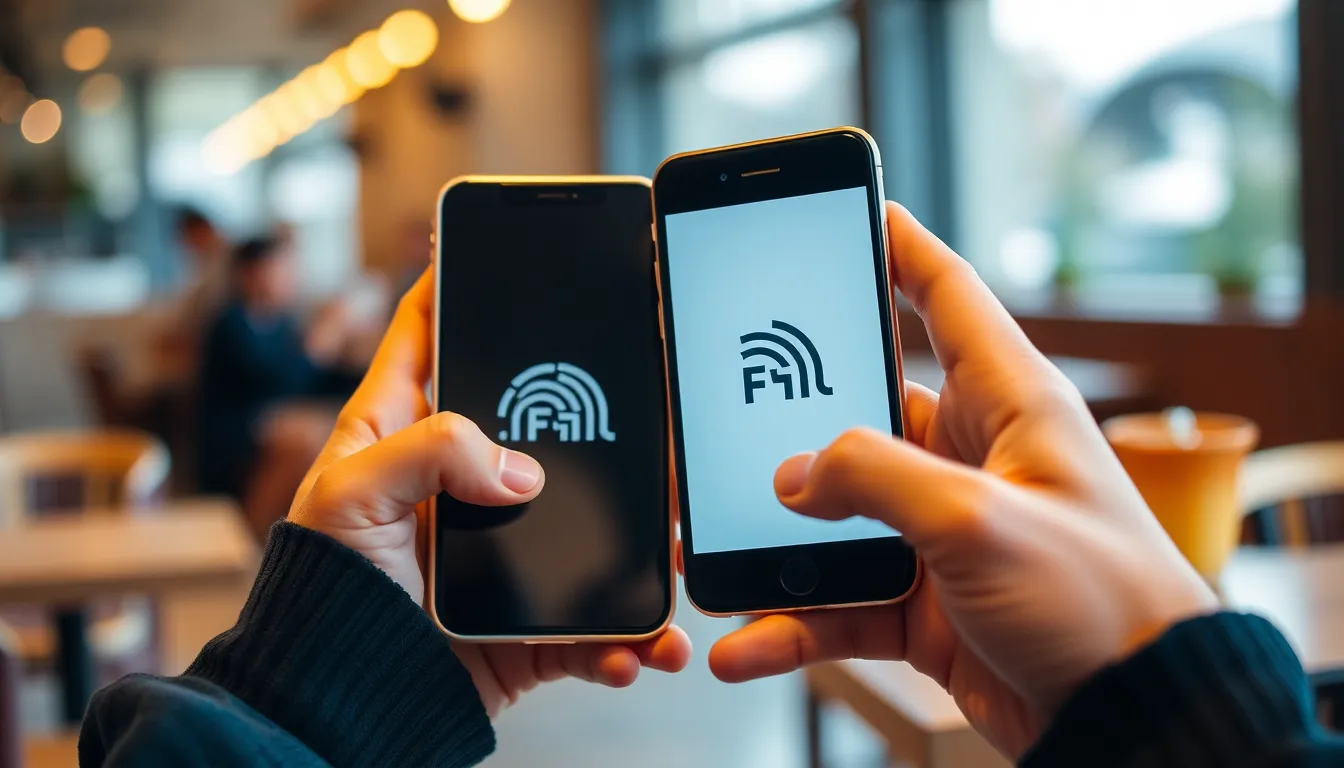NFC, or Near Field Communication, is a technology that’s transforming the way people interact with their smartphones. This short-range wireless communication allows devices to exchange data simply by being in close proximity, making everyday tasks like payments and data sharing more convenient than ever.
With NFC, users can tap their phones to make secure transactions, connect with other devices, or even access information without the hassle of complicated setups. As this technology continues to evolve, understanding its capabilities and benefits becomes essential for anyone looking to enhance their mobile experience. Whether it’s making a quick payment at a coffee shop or sharing contacts effortlessly, NFC is paving the way for a more connected world.
Table of Contents
ToggleWhat Is NFC on Phone?
NFC, or Near Field Communication, is a short-range communication technology embedded in many smartphones. NFC enables devices to exchange information with a simple tap or close proximity. This technology operates within a range of about 4 inches, which enhances security and reduces the risk of accidental connections.
NFC supports various functions on smartphones:
- Mobile Payments: NFC allows users to make secure transactions via digital wallets like Apple Pay and Google Pay, facilitating quick checkout experiences.
- Data Transfer: NFC enables the seamless sharing of contacts, photos, or files between devices. Users can simply tap their phones together to initiate the transfer process.
- Access Control: NFC facilitates secure access to devices or services, such as unlocking doors or boarding passes, enhancing user convenience.
- Pairing Devices: NFC simplifies the process of connecting devices like headphones or speakers, enabling instant pairing without complicated settings.
NFC technology enhances user experiences by providing quick and secure interactions in everyday activities. Its integration into smartphones continues to expand, offering innovative ways to connect and share information effortlessly.
How NFC Works

NFC technology operates through a simple yet effective communication process that enables devices to exchange data wirelessly over short distances. Understanding the mechanics behind NFC illuminates its functionality and usefulness in everyday applications.
Communication Process
NFC functions through inductive coupling between two devices. When two NFC-enabled devices come close to each other, they generate an electromagnetic field that allows them to share information. This method requires minimal setup, as it activates automatically when devices are within proximity—typically about 4 inches. Data transfer occurs in two primary modes: peer-to-peer mode for exchanging information between devices, and read/write mode, where one device reads from or writes to a passive NFC tag. This streamlined process ensures quick transactions, whether for payments or information sharing.
Technical Specifications
NFC technology functions at 13.56 MHz and typically supports data transfer rates of up to 424 Kbps. Devices utilize modulation techniques such as Amplitude Shift Keying (ASK) for communication. NFC operates within the ISO/IEC 14443 standard, ensuring compatibility across various devices, including smartphones, contactless cards, and tags. It requires a power supply, typically drawn from the active device, allowing passive devices to operate without a battery. The security aspects of NFC are robust, employing encryption and secure channel methods to protect data during transmission.
Uses of NFC in Smartphones
NFC technology plays a vital role in enhancing various functions within smartphones. Its capabilities include facilitating mobile payments, enabling quick data transfer, and utilizing smart tags for efficient access to information.
Mobile Payments
NFC simplifies mobile payments through digital wallets like Apple Pay, Google Pay, and Samsung Pay. Users tap their phones on NFC-enabled terminals to securely complete transactions. This process relies on tokenization, ensuring sensitive data remains protected during payments. According to a report by Statista, global mobile payment revenue reached approximately $1 trillion in 2023, illustrating the growing reliance on NFC technology in financial transactions.
Data Transfer
NFC significantly streamlines data transfer between devices. Users can exchange files, photos, or contact information simply by bringing two NFC-enabled smartphones close together. In peer-to-peer mode, devices share data quickly with minimal setup. For example, transferring a photo typically takes only seconds, enhancing user experience during file sharing. According to a study by the Mobile Marketing Association, 66% of users found NFC convenient for sharing information.
Smart Tags
NFC enables the use of smart tags, such as NFC stickers and cards, for easy access to information. Users scan these tags with their smartphones to retrieve web links, contact details, or other data instantly. This functionality improves marketing efforts and access control, allowing businesses to engage customers interactively. For instance, museum exhibits often utilize NFC tags, giving visitors additional information about displays directly on their smartphones.
Advantages of NFC Technology
NFC technology offers multiple advantages that enhance user experiences across various applications.
- Convenience: NFC enables quick interactions without the need for complex setups or device pairings. Users can complete transactions or share data with a simple tap.
- Speed: NFC facilitates rapid data transfer, with exchange times often lasting just seconds. This speed meets the demand for immediate access to information and services.
- Security: NFC ensures secure communications through encryption and secure channel methods. It minimizes risks associated with data transfer, keeping sensitive information safe.
- Energy Efficiency: NFC technology consumes low power, allowing devices to operate efficiently without draining batteries. This energy-saving aspect is crucial for mobile applications.
- Versatility: NFC supports a range of functionalities, from mobile payments to accessing smart tags. Its versatility makes it applicable in different sectors, including retail, public transportation, and marketing.
- User Engagement: NFC enhances customer interaction by enabling access to promotional content and information through smart tags. This capability helps businesses engage users effectively.
- Widespread Adoption: As NFC becomes standard in smartphones and various devices, its adoption continues to grow, establishing a robust ecosystem for seamless interactions.
Limitations of NFC Technology
NFC technology, despite its advantages, has several limitations that users should consider.
- Limited Range: NFC operates within a very short range of about 4 inches. This constraint necessitates close proximity for successful transactions or data transfers, making it less versatile than other wireless technologies like Bluetooth or Wi-Fi.
- Data Transfer Speed: NFC supports data transfer rates up to 424 Kbps. This speed, while adequate for small files like contact information, proves insufficient for larger files or extensive data transfers, often requiring alternative methods.
- Device Compatibility: Not all smartphones come equipped with NFC functionality. Users with older devices or specific models may find themselves unable to utilize NFC features, limiting overall accessibility.
- Security Risks: While NFC incorporates encryption for secure transactions, vulnerabilities still exist. Attackers could exploit weaknesses in the technology, particularly during sessions in crowded areas where unauthorized interception poses a risk.
- Limited Application Support: NFC functionality depends heavily on app support. Some applications may not offer NFC capabilities, restricting the full potential of the technology in various use cases.
- Cost Considerations: Integrating NFC technology into devices and systems can involve additional costs. Businesses may incur expenses when adopting NFC payment systems or related infrastructure, impacting overall implementation.
Awareness of these limitations is vital for users looking to maximize NFC’s benefits while navigating its drawbacks.
NFC technology is transforming how users interact with their smartphones. By enabling quick and secure transactions and data exchanges, it enhances daily activities and simplifies processes. As NFC continues to evolve, its applications will likely expand further, making mobile interactions even more seamless.
Understanding both the advantages and limitations of NFC is essential for users. Awareness of its range and potential security risks can help individuals make informed decisions about utilizing this technology effectively. The growing adoption of NFC in smartphones signifies its importance in the modern digital landscape, paving the way for a more connected future.




